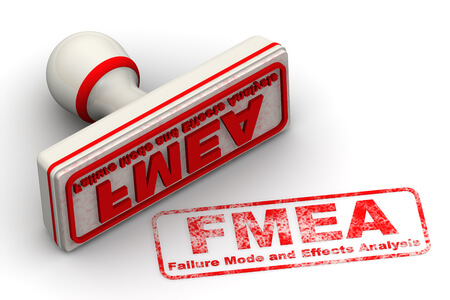Tagged: FMEA
Failure Modes and Effects Analysis in the Legislative Process
In my last post, I argued that the process of drafting new legislation should be undertaken with a problem-solving mindset. I suggested that problem-solving tools from a variety of disciplines could be advantageously adapted to the legislative process. In this post, I will present the manner in which one specific tool—Failure Modes and Effects Analysis (FMEA)—could be used in legislative drafting.
FMEA was originally developed as a tool to improve processes within the manufacturing industry. An FMEA is a “systemic method of identifying product and process problems before they occur.” Robin E. McDermott, Raymond J. Mikulak, Michael R. Beauregard, The Basics of FMEA 3 (1996). (Many of the details of the FMEA process discussed in this post come from The Basics of FMEA. I highly recommend that anyone interested in performing FMEAs in the legislative process read this book. The steps of an FMEA can be found in the book or online, here.) In the manufacturing context, the goal of an FMEA is to figure out how a new product or process is likely to fail, before that failure happens, and then to recommend improvements that will preemptively prevent the failure. In FMEA terminology, the process is designed to identify and resolve “failure modes” in a product or process.
In the legislative context, a bill working its way through the legislature can be thought of as the new “product or process” to which an FMEA can be applied. In this post, I will discuss where in the legislative process an FMEA could be performed, what the make-up of an FMEA team might be, and what beneficial output could be expected from an FMEA.
The authors of The Basics of FMEA, recommend that “[i]deally, FMEAs are conducted in the product design or process development stages, although conducting an FMEA on existing products and processes may also yield huge benefits.” The Basics of FMEA at 3. Likewise, a legislature could use FMEAs to analyze already existing laws. However, in this post, I will only describe FMEAs that would take place during the drafting process. Such an FMEA would likely be most useful to the legislative process after a committee performs hearings and before it votes on a bill. At this point, the committee has already gathered a wealth of useful information and the legislature still has wide latitude to make changes to the bill when potential failure modes are discovered.
The FMEA team itself should consist of four to six members. Id. at 15. Idealistically, the team will “bring a variety of perspectives and experiences to the project.” Id. This will likely result in team members having varying degrees of expertise in the relevant subject matter and a range of familiarity with the legislation being reviewed. For example, an FMEA team for a bill related to criminal justice might include: a legislative attorney familiar with the bill, a representative from the police force, an associate district attorney, a public defender, and representatives from advocacy groups or lobbyists. It is worth noting that many of the individuals on the team may be the same individuals who provided testimony in a committee hearing. Such overlap does not diminish the unique value that can be obtained by an FMEA. Likewise, an FMEA would in no way detract from the value of the committee hearing. Committee hearings give advocates an opportunity to state their case and respond to questions from members of the committee. The FMEA would give these individuals an opportunity to interact with one another and to work towards improving legislation in ways in which they can all agree.
It is also important to note that many of the FMEA team members may also represent the individuals that the law is meant to address—the “role occupants” and implementing agencies. See Ann Seidman & Robert B. Seidman, Instrumentalism 2.0: Legislative Drafting for Democratic Social Change, 5 Legisprudence 95, 95 (2011). The Seidmans note that a role occupant’s failure “to respond to a law’s commands, prohibitions or permissions, signifies . . .
that, in drafting the bill’s detailed prescriptions, the drafter failed adequately to take into account the relevant constraints and resources in the role occupant’s environment.” Id. at 136. Bringing representatives of role occupants and implementing agencies into the legislative process via FMEAs would help to reduce these drafting failures.
Of course, the ultimate language of a bill must be determined by legislators and legislative attorneys. Nevertheless, the recommendations of an FMEA team regarding specific bill language could be of significant help to those tasked with the actual drafting of the bill. An appropriate balance of power between drafters and the FMEA team can be established by providing FMEA teams with “clearly defined boundaries within which they are free to conduct the FMEA and suggest and implement solutions.” The Basics of FMEA at 20-23. For example, the scope of a drafting-focused FMEA could be limited to the language of the bill, excluding considerations of the substantive legislative plan embodied in the bill. While a broad legislative scheme may be well suited to effectuate desired change, the language of a bill may fail to adequately implement the legislative plan. Such an FMEA could identify, document, and recommend corrections to any problematic drafting discovered. Once the bill is revised, the FMEA team could re-convene and repeat its analysis.
Whenever a new step is added to a process, a fear may arise that the process is becoming more complex, and therefore less efficient. The inclusion of FMEAs in the process of drafting legislation would undoubtedly require legislative drafters to overcome a steep learning curve. Once that learning curve is overcome, however, use of the FMEA methodology will yield significant benefits. In the short term, the FMEA could uncover and correct potential problems in a bill before it leaves its committee. In the long term, effective FMEAs would decrease the likelihood that laws would need to be revised to address problems that were not foreseen during the drafting process. Idealistically, the end result will be a more efficient legislative drafting process resulting in the passing of better drafted laws.
 Andrew P. McDonough graduated from Boston University School of Law in May 2018.
Andrew P. McDonough graduated from Boston University School of Law in May 2018.

